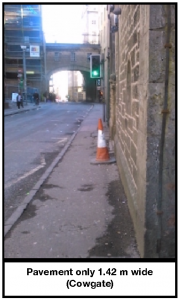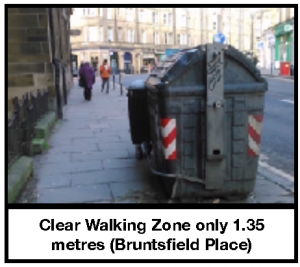In 2015, the City of Edinburgh Council adopted new Street Design Guidance. This sets out the standards and requirements for how the city’s streets are to be designed, maintained and managed. Fundamental to the Guidance is ‘walkability’ – wider pavements, less street clutter, less dominant traffic. “Everyone who manages, maintains, alters or reconstructs streets, including urban paths, will be expected to comply with the Guidance” (p8).
The Living Streets Edinburgh Group has prepared this briefing paper to help anyone wanting to campaign for a more walkable Edinburgh, by setting out some key requirements contained in the Guidance. For full details, see http://www.edinburgh.gov.uk/info/20089/roads_and_pavements/906/edinburgh_street_design
Pavement widths
T he Council classifies all Edinburgh streets: for example as “Retail/High Street”, “High Density Residential”, “Low Density Residential“ etc. It further classifies streets as ‘Strategic’, ‘Secondary’ or ‘Local’.
he Council classifies all Edinburgh streets: for example as “Retail/High Street”, “High Density Residential”, “Low Density Residential“ etc. It further classifies streets as ‘Strategic’, ‘Secondary’ or ‘Local’.
A minimum, and desirable, width applies for each different type of street. However, no pavement on any street should be less than 2 metres wide. Some key standards are:
Retail/High streets:
“absolute minimum 2.5m (only allowed in short sections), general min 3m, desirable min 4m or wider”
High density residential (Strategic and secondary):
“absolute min. 2m (only allowed in short sections), general minimum 2.5m, desirable min 3m or wider”
All streets:
“absolute minimum of 2m (only allowed in short sections), general min of at least 2.5 m or wider.”
 “Clear Walking Zone”
“Clear Walking Zone”
This is the space on a pavement that must be kept clear of *any* obstructions (lamp posts, A-boards, bins, bus shelters, signage poles, etc):
All streets: 1.5 metres minimum Clear Walking Zone
This document is available as a downloadable PDF here – Living-Streets-Edinburgh-Street-Design-Clear-Pavements